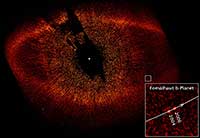|
COMETS EARTH JUPITER KUIPER BELT MARS MERCURY METEORITES NEPTUNE OORT CLOUD PLUTO SATURN SOLAR SYSTEM SPACE SUN URANUS VENUS ORDER PRINTS
PHOTO CATEGORIES SCIENCEVIEWS AMERICAN INDIAN AMPHIBIANS BIRDS BUGS FINE ART FOSSILS THE ISLANDS HISTORICAL PHOTOS MAMMALS OTHER PARKS PLANTS RELIGIOUS REPTILES SCIENCEVIEWS PRINTS
|
Related Documents
Download Options
This image, taken with the Advanced Camera for Surveys aboard NASA's Hubble Space Telescope, shows the newly discovered planet, Fomalhaut b, orbiting its parent star, Fomalhaut. The small white box at lower right pinpoints the planet's location. Fomalhaut b has carved a path along the inner edge of a vast, dusty debris ring encircling Fomalhaut that is 21.5 billion miles across. Fomalhaut b lies 1.8 billion miles inside the ring's inner edge and orbits 10.7 billion miles from its star. The inset at bottom right is a composite image showing the planet's position during Hubble observations taken in 2004 and 2006. Astronomers have calculated that Fomalhaut b completes an orbit around its parent star every 872 years. The white dot in the center of the image marks the star's location. The region around Fomalhaut's location is black because astronomers used the Advanced Camera's coronagraph to block out the star's bright glare so that the dim planet could be seen. Fomalhaut b is 1 billion times fainter than its star. The radial streaks are scattered starlight. The red dot at lower left is a background star. The Fomalhaut system is 25 light-years away in the constellation Piscis Australis. This false-color image was taken in October 2004 and July 2006. Credit: NASA, ESA, P. Kalas, J. Graham, E. Chiang, E. Kite (University of California, Berkeley), M. Clampin (NASA Goddard Space Flight Center), M. Fitzgerald (Lawrence Livermore National Laboratory), and K. Stapelfeldt and J. Krist (NASA Jet Propulsion Laboratory) |
